Understanding where students, recent grads, and alum are going after they graduate is critical to develop the best strategies to attract them.
Today’s students and recent grads have had a college experience interrupted by the pandemic. They’re entering the workforce during uncertain economic times as the US continues to recover and react to new macro trends. And digital transformation has put potential into the palms of their hands—virtual recruiting has removed some barriers and expanded access to opportunity, particularly for students from underrepresented backgrounds.
Although remote work is still popular, with 41% percent of students saying they’re more likely to apply to a hybrid job, 72% of applications on Handshake in the last year were submitted to roles with a distinct job location. Understanding where students are interested in living and working is one of the most pressing questions for employers today.
We took a look at Handshake data over the past year compared with pre-pandemic data to explore how students’ location preferences may have changed—and what this means for you.
Consider these 3 key takeaways as you scroll:
1. Use data to inform your location strategy
2. Rethink your core school strategy
3. Cast a wider net with a hybrid strategy
Which cities receive the most applications from students and recent grads?
Big Apple, big interest
While New York City received the most applications from early talent candidates before the pandemic, its popularity continues to rise: the Big Apple saw 6.7x more applications between 2022-2023 compared to the same time period in 2018-2019. Over the last year, New York City also received twice as many applications as the next most-popular city (Chicago).

Top 15 cities with the most applications in the US
Miami, Atlanta, and Philadelphia have risen in popularity for graduating students and alums over the last year, while Seattle, San Diego, and San Francisco have fallen several spots since before the pandemic. However, the top 15 cities have overall remained consistent when comparing data pre-pandemic and post-pandemic.
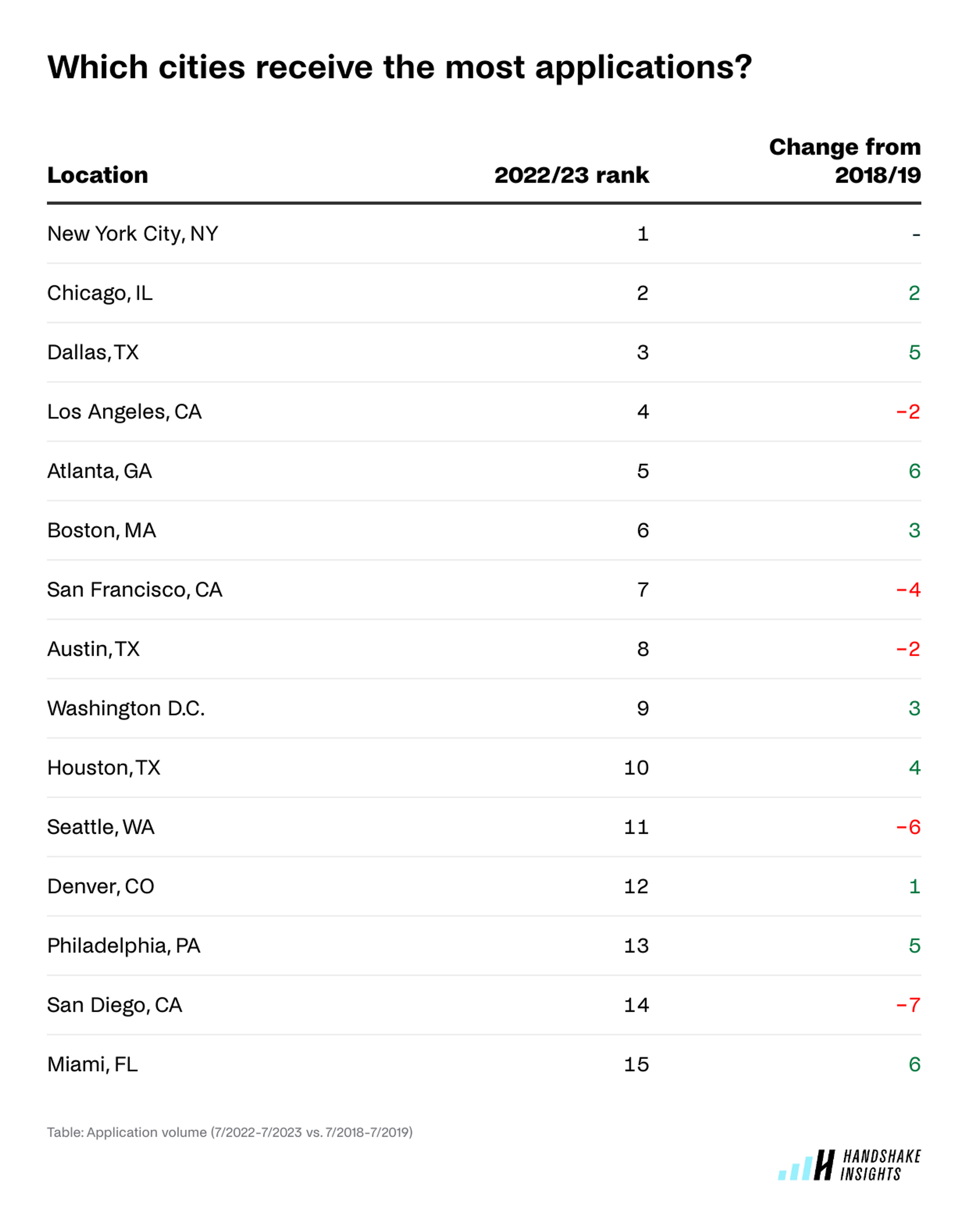
Are more applications submitted in state or out of state?
83% of applications are submitted out of state
Students on Handshake are increasingly showing a willingness to apply to jobs outside of their current school location.
Before the pandemic, only 44% of applications, on average, were submitted to jobs outside students’ current states. In 2022-2023, however, 83% of applications, on average, were submitted to jobs outside candidates’ current states—a whopping increase of 39 percentage points.
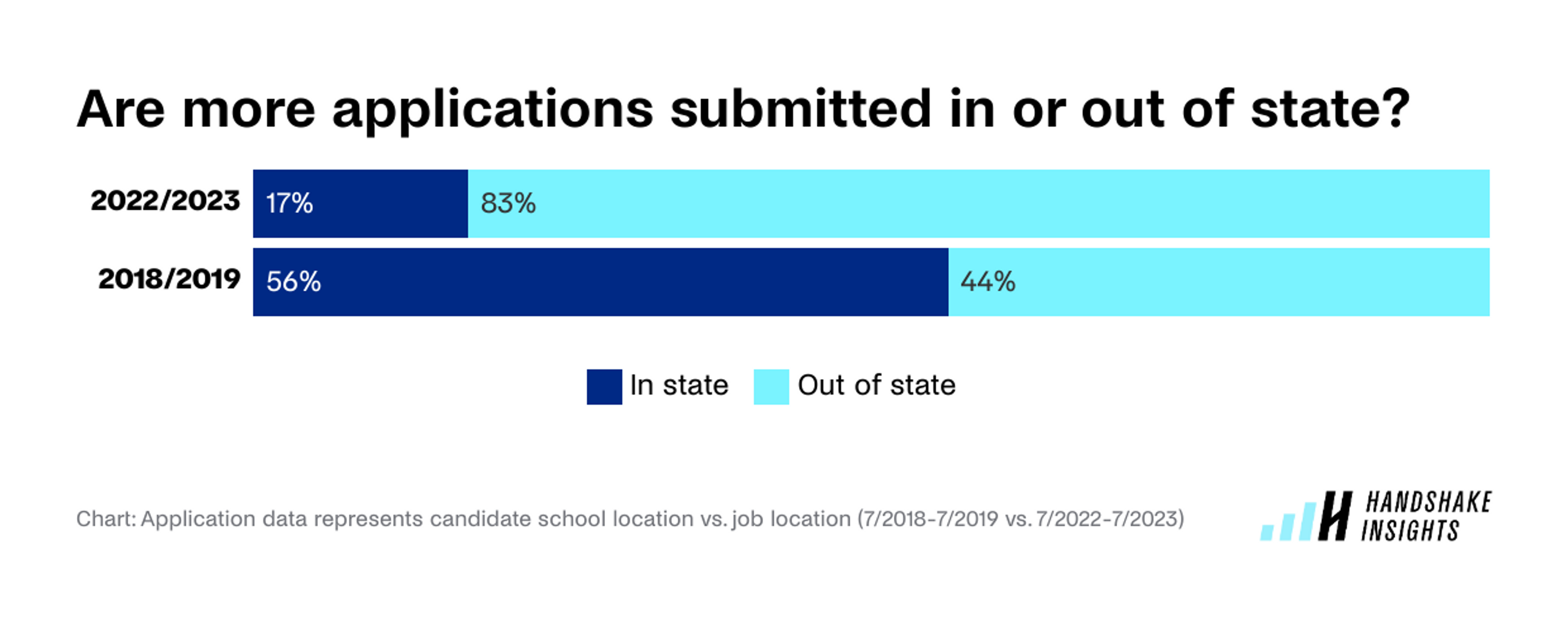
What does this mean for you? Recruiting from schools local to your physical offices is an outdated strategy and leaves talent on the table. Casting a wider net gives you a better chance at attracting top talent. Shift your mindset and start to look past traditional sourcing methods to tap the most skilled, diverse talent pools nationwide.
What do regional job application patterns look like across the US?
Understanding where candidates are interested in working is top of mind for many, as employers often partner with Handshake Insights for guidance on location strategy. While it's true that a large number of applications are submitted to jobs within the candidate’s current region, applicants show an openness to move for the right opportunity. But no matter where you are based, you have an opportunity to attract top early talent with a national strategy.
Where are students in the West applying?
Of all applications from students and recent grads at schools in the West, 39% were to jobs in that region. So while many students are looking to stay in the region, others are also looking to explore different parts of the country. Students in the West show an openness to apply to jobs across the US given there’s not a single city that commands an outsize share of applications.
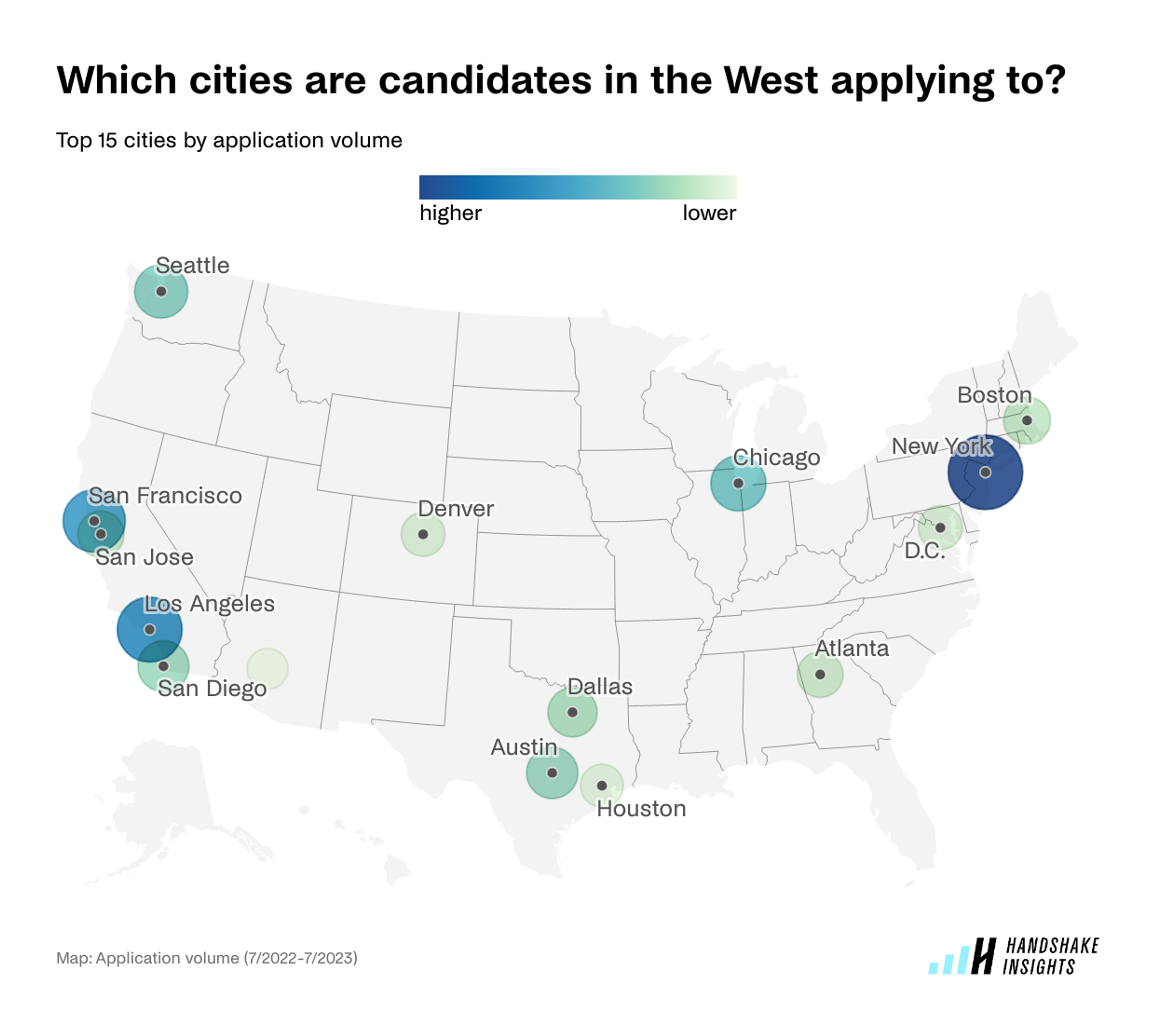
Top 15 cities college students and recent grads in the West are applying to: #1 New York City #2 Los Angeles #3 San Francisco #4 Chicago #5 Seattle #6 Austin #7 San Diego #8 Dallas #9 Boston #10 San Jose #11 Atlanta #12 Washington, DC #13 Denver #14 Houston #15 Phoenix
Where are students in the Midwest applying?
Of all applications from students and recent grads at schools in the Midwest, 31% were to jobs in that region. This means that the Midwest region is attracting students from other regions, too. But Chicago is the main draw: 30% of all applications from candidates in the Midwest are submitted to jobs in Chicago.
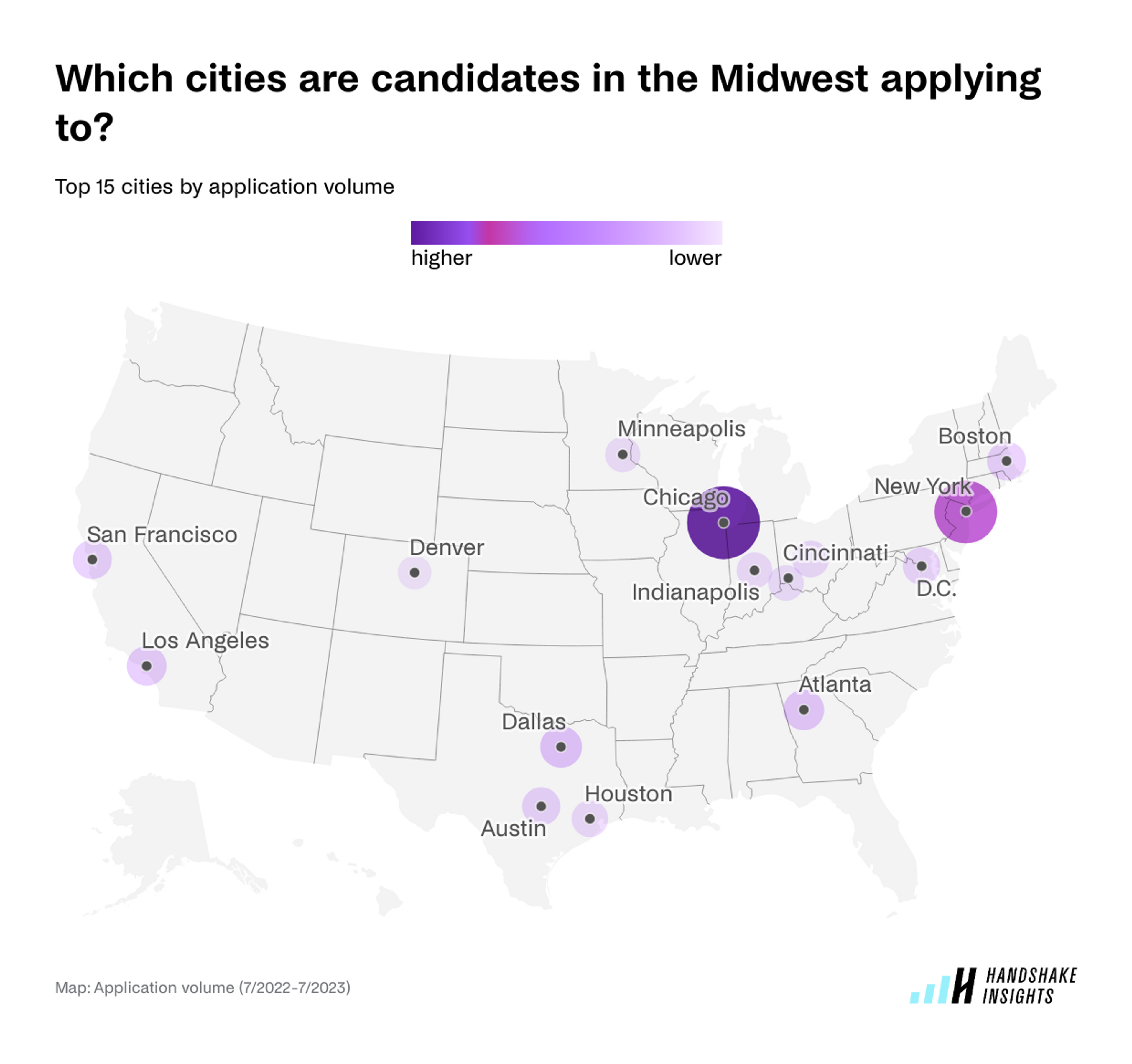
Top 15 cities college students and recent grads in the Midwest are applying to: #1 Chicago #2 New York City #3 Dallas #4 Atlanta #5 Los Angeles #6 San Francisco #7 Boston #8 Austin #9 Washington, DC #10 Columbus #11 Houston #12 Indianapolis #13 Cincinnati #14 Minneapolis #15 Denver
Where are students in the South applying?
Of all applications from students and recent grads at schools in the South, 45% were to jobs in that region. Texas is the dominant state where students in the South are applying in the region. Given Texas has several large metro areas, students and recent grads have many locations to choose from in Texas alone.
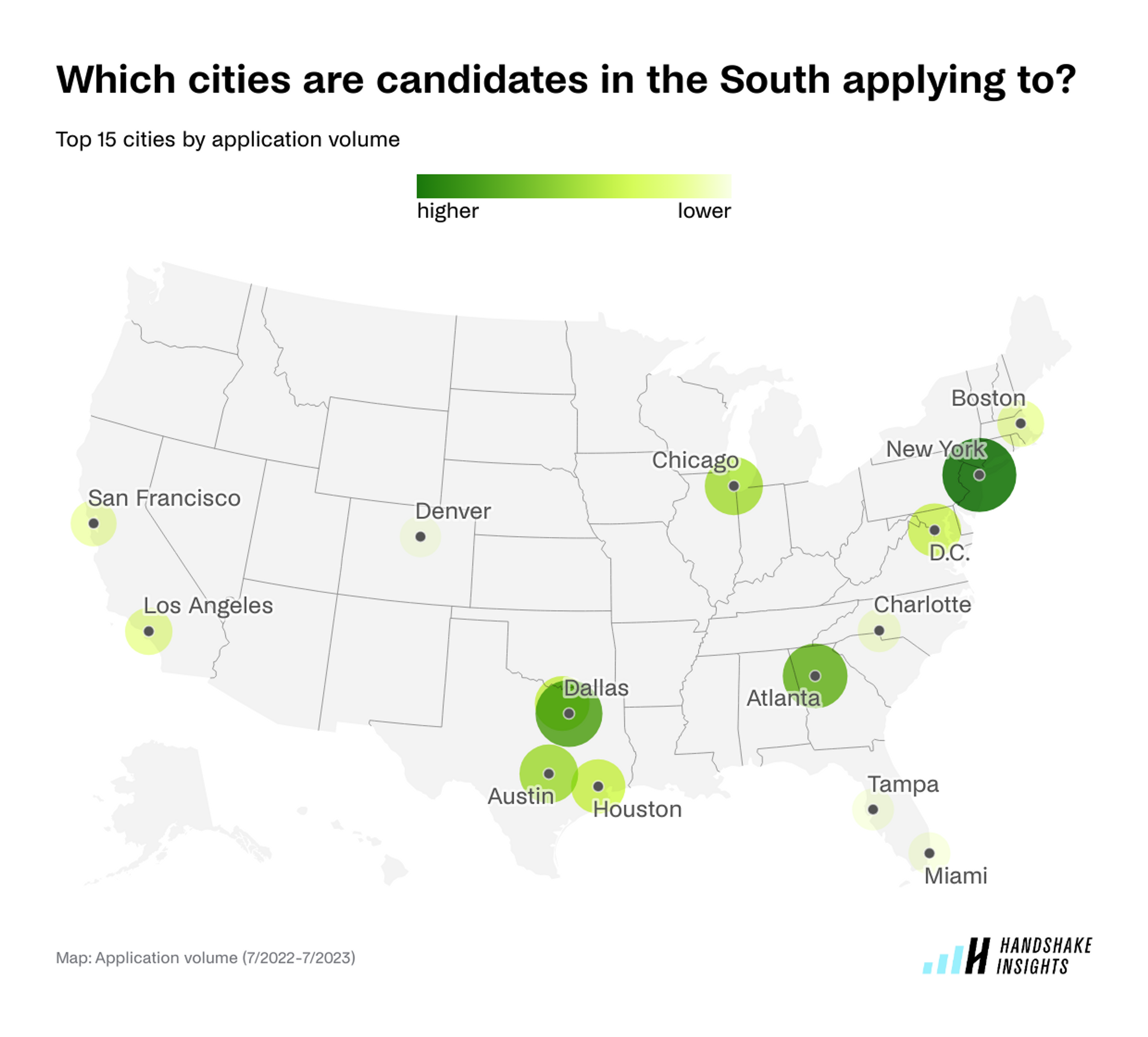
Top 15 cities college students and recent grads in the South are applying to: #1 New York City #2 Dallas #3 Atlanta #4 Austin #5 Chicago #6 Denton #7 Houston #8 Washington, DC #9 Los Angeles #10 Boston #11 San Francisco #12 Charlotte #13 Miami #14 Tampa #15 Denver
Where are students in the Northeast applying?
Of all applications from students and recent grads at schools in the Northeast, 41% were to jobs in that region. Despite the density of cities in the region, New York City is the top city drawing applications in the region, with 29% of all applications from candidates in the Northeast.
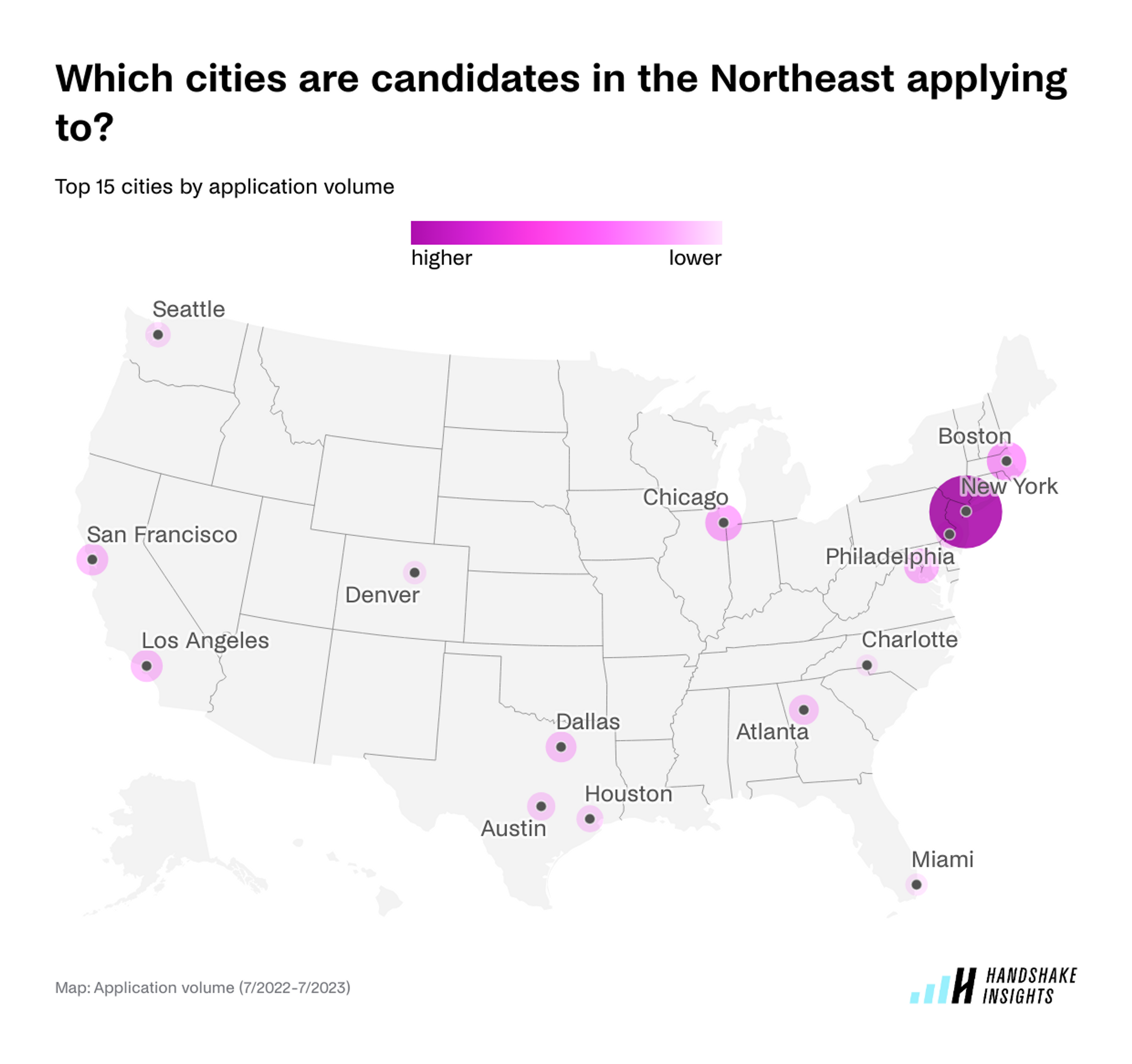
Top 15 cities college students and recent grads in the Northeast are applying to: #1 New York City #2 Boston #3 Chicago #4 Washington, DC #5 Los Angeles #6 San Francisco #7 Dallas #8 Atlanta #9 Austin #10 Philadelphia #11 Houston #12 Seattle #13 Denver #14 Miami #15 Charlotte
Three key takeaways & next steps
While you can draw inferences for your specific location, hiring needs, and strategy, the following recommendations can help you get started on updates you might want to make:
1. Use data to inform your location strategy.
Candidates are keeping their options open beyond their current location. The case for employers to source candidates nationwide has never been stronger. Leverage Handshake data to uncover qualified candidates for your roles and use more modern sourcing strategies to engage them.
2. Rethink your school strategy.
This data shows that students and recent grads are more open now than in the past to applying to locations beyond where they attend or attended school. Why limit your recruiting strategy to partnerships with schools that are local? Engage top talent regardless of their school’s location.
3. Cast a wider net with a hybrid strategy.
Leverage hybrid tactics to engage candidates outside of your traditional parameters. For example, host virtual events with schools outside your region, use messaging Campaigns to promote your brand and job opportunities to targeted cohorts of students, and maximize ROI by going in person to a select number of campuses that are strategic for your business needs.
Talent is everywhere
The data in these charts, maps, and graphs can help you make informed decisions about where, how, and whom you’re recruiting for entry level roles at your organization.
From finding the right school partnerships to attract the talent you need, to learning how you can use Handshake to expand access to opportunities for students who might not be where you typically look for them, you can use this data to inform your early talent programs.
Want more information around your location-based hiring data or other geographic trends across Handshake's network? Handshake Insights gives you real-time data to help you understand your unique challenges and opportunities.
Get in touch with the Insights team.
Methodology
The total number of applications submitted to jobs in a city gives us a sense of students’ interest in working in that location. Throughout this analysis, we use total application volume to rank student interest. Charts in this analysis represent Handshake application data from 7/1/2022—7/2023. When indicated, some charts compare application data from 7/1/2022—7/2023 to 7/1/2018—7/1/2019. Application data includes both students and alumni on Handshake.
